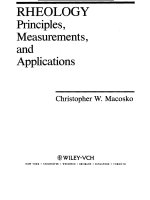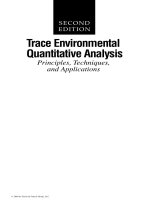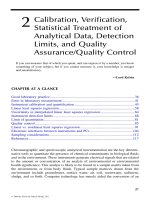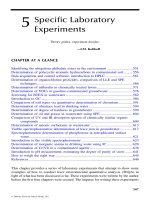rheology -principles, measurements, and applications
Bạn đang xem bản rút gọn của tài liệu. Xem và tải ngay bản đầy đủ của tài liệu tại đây (23.17 MB, 578 trang )
~~ ~
RHEOLOGY
Principles,
Measurements
and
Applications
Christopher
W.
Macosko
8
WILEY-VCH
NEW YORK CHICHESTER
*
WEINHEIM
*
BRISEANE SINGAPORE
TORONTO
This book is printed on acid-free paper.
Copyright
0
1994 by Wiley-VCH, Inc.
All
rights reserved.
Originally published
as
ISBN 1-56081-579-5.
Published simultaneously in Canada.
No
part of this publication may
be
reproduced, stored in a retrieval system
or
transmitted in any
form
or
by any means, electronic, mechanical, photocopying, recording, scanning
or
otherwise,
except
as
permitted under Sections 107
or
108
of
the 1976 United States Copyright Act, without
either the prior written permission of the Publisher,
or
authorization through payment of the
appropriate per-copy fee to the Copyright Clearance Center, 222 Rosewood Drive, Danvers,
MA
01923, (978) 750-8400, fax (978) 750-4744. Requests to the Publisher
for
permission should
be
addressed
to
the Permissions Department, John Wiley
&
Sons, Inc., 605 Third Avenue, New York,
NY
10158-0012, (212) 850-6011, fax (212) 850-6008, E-Mail:
Library
of
Congress
Cataloging-in-Publication Data:
Macosko, Christopher W.
Rheology
:
principles, measurements, and applications
/
by
Christopher W. Macosko
:
with contributions by
Ronald
G.
Larson.
.
.
[et
al.].
p. cm (Advances in interfacial engineering series)
Includes bibliographical references and index.
ISBN 0-471-18575-2 (alk. paper)
1. Rheology. I. Larson, RonaldG.
11.
Title. III. Series.
QC189.5.M33 1993
531’.1l-d~20 93-31652
CIP
Printed in the United States of America.
20 19 18 17 16
15
14 13
Even the mountains flowed
before the
Lord.
From
the song of Deborah
after her victory over the
Philistines, Judges
55,
translated by
M.
Reiner
(Physics
Today,
January
1964,
Q.
62).
The Soudan Iron Formation exposed
in
Tower-Soudan State Park
near Tower, Minnesota. This rock was originally deposited as
horizontal layers
of
iron-rich sediments at the bottom
of
a sea.
Deposition took place more than a billion years ago,
in
the Precam-
brian era
of
geologic time. Subsequent metamorphism, deforma-
tion, and tilting
of
the rocks have produced the complex structures
shown. (Photo by
A.G.
Fredrickson, University
of
Minnesota.)
DEDICATION
A.M.D.G.
This book has been written in the spirit that energized far greater
scientists. Some of them express that spirit in the following
quo-
tations.
“This most beautiful system
of
the sun, planets and comets could
only proceed from the counsel and dominion
of
an intelligent and
powerful Being.”
Isaac
Newton
“Think what God has determined to do to all those who submit
themselves
to
His
righteousness and are willing to receive
His
ggt.
”
James
C.
Maxwell
June
23,
1864
“Zn the distance tower
still
higher peaks, which will yield to those
who ascend them still wider prospects, and deepen the feeling
whose truth
is
emphasized by every advance in science, that ‘Great
are the works of the Lord’
”.
J.J. Thomson,
Nature, 81,
257
(1909).
ACKNOWLEDGMENTS
This text has grown out of a variety
of
teaching and consulting
efforts.
I
have used part of the material for the past several years
in
a course
on
polymer processing at the University of Minnesota
and nearly all of
it
in
my graduate course, Principles and Appli-
cations
of
Rheology. Much
of
my
appreciation for the needs of the
industrial rheologist has come from teaching a number
of
short
courses
on
rheological measurements at Minnesota and for the
So-
ciety of Rheology and Society of Plastics Engineers. The Univer-
sity of Minnesota summer short course has been taught for nearly
20
years with over
800
attendees. Many
of
the examples, the top-
ics, and the comparisons of rheological methods included here
were motivated by questions from short course students. Video
tapes
of
this course which follows this text closely are available.
My
consulting work, particularly with Rheometrics, Inc., has pro-
vided me the opportunity to evaluate many rheometer designs, test
techniques, and data analysis methods, and fortunately
my
con-
tacts have not been shy about sharing some of their most difficult
rheological problems.
I
hope that the book’s approach and content
have benefited from this combination of academic and industrial
applications of rheology.
As
indicated in the Contents, two of the chapters were writ-
ten by my colleagues at the University of Minnesota, Tim Lodge
and Matt Tirrell. With Skip Scriven, we have taught the Rheolog-
ical Measurements short course at Minnesota together for several
years. Their contributions of these chapters and their encourage-
ment and suggestions
on
the rest of the book have been a great
help. Ron Larson, a Minnesota alumnus and distinguished member
of the technical staff at ATT Bell Labs, contributed Chapter
4
on
nonlinear viscoelasticity. We are fortunate to have this expert con-
tribution, a distillation of key ideas from his recent book
in
this
area.
I
collaborated with Jan Mewis of the Katholieke Universiteit
Leuven
in
Belgium
on
Chapter
10
on
suspensions. Jan’s expertise
and experience in concentrated suspensions
is
greatly appreciated.
Robert Secor, now
of
3M, prepared Appendix
A
to Chapter 3, con-
cerned with fitting linear viscoelastic spectra, during his graduate
studies here. Mahesh Padmanabhan was very helpful in prepara-
tion of much
of
the final version, particularly
in
writing and editing
parts of Chapters
6
and
7
as well as
in
preparing the index.
This manuscript has evolved over a number
of
years, and
so
many people have read and contributed that
it
would be impossible
to acknowledge them all. My present and past students have been
particularly helpful
in
proofreading and making up examples.
In
addition, my colleagues Gordon Beavers and Roger Fosdick read
early versions of Chapters
1
and
2
carefully and made helpful sug-
gestions.
A
major part of the research and writing of the second sec-
tion
on
rheometry was accomplished while
I
was a guest of Martin
xvii
Laun in the Polymer Physics Laboratory, Central Research of
BASF
in
Ludwigshafen, West Germany. The opportunity to dis-
cuss and present this work with Laun and his co-workers greatly
benefited the writing. Extensive use of their data throughout this
book is a small acknowledgment
of
their large contribution to the
field
of
rheology.
A
grant from the Center for Interfacial Engineering has been
very helpful in preparing the manuscript. Julie Murphy supervised
this challenging activity and was ably assisted by Bev Hochradel,
Yoav Dori, Brynne Macosko, and Sang Le. The VCH editorial and
production staff, particularly Camille Pecoul, did a fine job.
I
apol-
ogize in advance for any errors which we all missed and welcome
corrections from careful readers.
Chris Macosko
August
1993
xViii
/
ACKNOWLEDGMENTS
PREFACE
Today a number of industrial and academic researchers would like
to use rheology to help solve particular problems. They really
don’t want to become full-time rheologists, but they need rheolog-
ical measurements to help them characterize a new material, ana-
lyze a non-Newtonian flow problem, or design a plastic part.
l
hope this book will meet that need.
A
number of sophisticated
in-
struments are available now for making rheological measurements.
My
goal is to help readers select the proper type of test for their
applications, to interpret the results, and even to determine
whether or not rheological measurements can help to solve a par-
ticular problem.
One of the difficult barriers between
much
of the rheology
literature and those who would at least like to make its acquain-
tance,
if
not embrace it, is the
tensor.
That monster of the double
subscript has turned back many a curious seeker of rheological
wisdom. To avoid tensors, several applied rheology books have
been written
in
only one dimension. This can make the barrier
seem even higher by avoiding even a glimpse of
it.
Furthermore,
the one-dimensional approach precludes presentation of a number
of useful, simplifying concepts.
1
have tried to expose the tensor monster as really quite a
friendly and useful little man-made invention for transforming vec-
tors. It greatly simplifies notation and makes the three-dimensional
approach to rheology practical.
I
have tried to make the incorpo-
ration of tensors as simple and physical as possible. Second-order
tensors, Cartesian coordinates, and a minimum
of
tensor manipu-
lations are adequate to explain the basic principles of rheology and
to give a number of useful constitutive equations. With what is
presented
in
the first four chapters, students will be able to read
and use the current rheological literature. For curvilinear coordi-
nates and detailed development of constitutive equations, several
good texts are available and are cited where appropriate.
Who should read this book, and how should it be used? For
the seasoned rheologist or mechanicist, the table of contents
should serve as a helpful guide. These investigators may wish to
skim over the
first section
but perhaps will find its discussion of
constitutive relations
and material functions with the inclusion of
both solids and liquids helpful and concise.
I
have found these four
chapters on constitutive relations a very useful introduction to
rheology for first- and second-year engineering graduate students.
1
have also used portions
in
a senior course
in
polymer processing.
The rubbery solid examples are particularly helpful for later de-
velopment of such processes as thermoforming and blow molding.
There are a number of worked examples which students report are
helpful, especially
if
they
attempt to do them before reading the
solutions. There are additional exercises at the end of each chap-
ter. Solutions to many of these are found at the end of the text.
xv
In Part
I
of the book we only use the simplest deformations,
primarily simple shear and uniaxial elongation, to develop the im-
portant constitutive equations.
In
Part
I1
the text describes
rheo-
meters,
which can measure the material functions described in
Chapters
1
through
4.
How can the assumed kinematics actually
be achieved in the laboratory'? This rheometry material can serve
the experienced rheologist as
a
useful reference to the techniques
presently available. Each of the major test geometries is described
with the working equations, assumptions, corrections, and limita-
tions summarized
in
convenient tables. Both shear and extensional
rheometers are described. Design principles
for
measuring stress
and strain
in
the various rheometers should prove helpful to the
new user as well as to those trying to build
or
modify instruments.
The important and growing application of optical methods in rheol-
ogy is also described.
The reader who is primarily interested in using rheology
to
help solve
a
specific and immediate problem can go directly to a
chapter
of
interest in Part I11 of the book on
applications
of
rheol-
ogy.
These chapters are fairly self-contained. The reader can
go
back to the
constitutive equation
chapters as necessary for more
background
or
to the appropriate rheometer section to learn more
about a particular test method. These chapters are not complete
discussions of the application of rheology to suspensions and poly-
meric liquids; indeed an entire book could be, and some cases has
been, written on each one. However, useful principles and many
relevant examples are given in each area.
xvi
I
PREFACE
CONTENTS
Part
I.
CONSTITUTIVE RELATIONS
1
1
/
Elastic
Solid
5
Christopher
W.
Macosko
1.1
1.2
1.3
1.4
1.5
I
.6
1.7
1.8
1.9
1.10
Introduction
5
The Stress Tensor
8
1.2.1
Notation
11
1.2.2
Symmetry
16
1.2.3
Pressure
18
Principal Stresses and Invariants
20
Finite Deformation Tensors
24
1.4.1
Finger Tensor
29
1.4.2
Strain Tensor
32
1.4.3
Inverse Deformation Tensors
32
1.4.4
Principal Strains
34
Neo-Hookean Solid
37
1.5.1
Uniaxial Extension
38
1.5.2
Simple Shear
40
General Elastic Solid
40
1.6.1
Strain-Energy Function
42
1.6.2
Anisotropy
44
1.6.3
Rubber-like Liquids
45
Equations
of
Motion
45
1.7.1
Mass Balance
45
1.7.2
Momentum Balance
47
Boundary Conditions
52
Summary
58
Exercises
59
References
62
2
/
Viscous
Liquid
65
Christopher
W.
Macosko
2.1
Introduction
65
2.2
Velocity Gradient
68
2.3
Newtonian Fluid
77
2.4
General Viscous Fluid
83
2.2.1
Rate of Deformation Tensor
72
2.3.1
Uniaxial Extension
79
2.4.1
Power Law
84
2.4.2
Cross Model
86
vii
2.4.3
Other Viscous Models
86
2.4.4
The Importance
of
ZZm
89
2.4.5
Extensional Thickening Models
91
2.5.1
Other Viscoplastic Models
95
2.6.1
Equations
of
Motion
99
2.6.2
Boundary Conditions
99
2.6.3
Energy Equation
100
2.6.4
Temperature and Pressure Dependence of
Viscosity
100
2.5
Plastic Behavior
92
2.6
Balance Equations
98
2.7
Summary
104
2.8
Exercises
105
References
106
3
/
Linear
Vkwlasticity 109
3.1
Introduction
109
3.2
General Linear Viscoelastic Model
111
3.2.
I
Relaxation Spectrum
115
3.2.2
Linear Viscoelasticity
in
Three Dimensions
I
I5
3.2.3
Differential Form
115
3.3
Small Strain Material Functions
117
3.3.1
Stress Relaxation
118
3.3.2
Creep
119
3.3.3
Sinusoidal Oscillations
121
Christopher
W.
Macosko
3.4
Exercises
126
Appendix3A
127
Robert
B.
Secor
Curve Fitting
of
Relaxation Modulus
Approximating Form
127
Error Measure
128
Search Procedures
129
References
133
127
4
/
Nonlinear
Vkwlasticity 135
Ronald
G.
Larson
4.1
Introduction
135
4.2
Nonlinear Phenomena
138
4.2.1
Normal Stress Difference
in
Shear
138
4.2.2
Shear Thinning
139
4.2.3
Interrelations Between Shear
4.2.4
Extensional Thickening
142
Functions
140
Viii
/
CONTENTS
4.3
Simple Nonlinear Constitutive Equations
I46
4.3.1
Second-Order Fluid
I46
4.3.2
Upper-Convected Maxwell Equation
149
4.3.3
Lodge Integral Equation
I53
4.4
More Accurate Constitutive Equations
I58
4.4.1
Integral Constitutive Equations
I58
4.4.2
Maxwell-Type Differential Constitutive
Equations
166
4.5
Summary
I70
4.6
Exercises
I71
References
I72
Part
II.
MEASUREMENTS:
RHEOMETRY
175
5
/
Shear
Rheometry:
Drag
Flows
181
Christopher
W.
Macosko
5.1
Introduction
181
5.2
Sliding Plates, Falling Ball
184
5.2.1
Falling Cylinder
185
5.2.2
Falling Ball
I87
5.2.3
Rolling Ball
187
5.3.1
Shear Stress
190
5.3.2
Shear Strain and Rate
I91
5.3.3
Normal Stresses
in
Couette Flow
I95
5.3.4
Rod Climbing
I98
5.3.5
End Effects
200
5.3.6
Secondary Flows
202
5.3.7
Shear Heating
in
Couette Flow
203
5.4
Cone and Plate Rheometer
205
5.4.1
Shear Stress
206
5.4.2
Shear Strain Rate
207
5.4.3
Normal Stresses
208
5.4.4
Inertia and Secondary Flow
209
5.4.5
Edge Effects with Cone and Plate
213
5.4.6
Shear Heating
216
5.4.7
Summary
216
5.5.1
Normal Stresses
221
5.6.1
Rotating Disk
in
a Sea
of
Fluid
223
5.6.2
Rotating Vane
224
5.6.3
Helical Screw Rheometer
224
5.6.4
Instrumented Mixers
225
5.7.1
Rotating Cantiliver Rod
227
5.3
Concentric Cylinder Rheometer
188
5.5
Parallel Disks
217
5.6
Drag Flow Indexers
222
5.7
Eccentric Rotating Geometries
226
CONTENTS
1
h
5.7.2
Eccentric Rotating Disks
227
5.7.3
Other Eccentric Geometries
231
References
23
I
6
/
Shear
Rheometry:
Pressure-
Driven
Flows
237
Christopher
W.
Macosko
6.1
Introduction
237
6.2
Capillary Rheometer
238
6.2.1
Shear Rate
240
6.2.2
Wall Slip, Melt Fracture
244
6.2.3
True Shear Stress
247
6.2.4
Shear Heating
252
6.2.5
Extrudate Swell
254
6.2.6
Melt Index
256
6.3.1
Normal Stresses
260
6.3.2
Exit Pressure
261
6.3.3
Pressure Hole
262
6.4
Other Pressure Rheometers
266
6.4.1
Axial Annular
Flow
266
6.4.2
Tangential Annular Flow
267
6.4.3
Tilted
Open
Channel
268
6.4.4
Squeezing Flow
270
6.5
Comparison of Shear Methods
275
6.6
Summary
277
6.3
Slit
Rheometry
257
References
280
7
/
Extensional
Rheometry
285
Christopher
W.
Macosko
7.1
Introduction
285
7.2
Simple Extension
288
7.2.1
End Clamps
291
7.2.2
Rotating Clamps
292
7.2.3
Buoyancy Baths
294
7.2.4
Spinning Drop
2%
7.3
Lubricated Compression
297
7.3.1
Planar Squeezing
303
7.4
Sheet Stretching, Multiaxial Extension
303
7.4.1
Rotating Clamps
304
7.4.2
Inflation Methods
306
7.5.7
Tubeless Siphon
315
7.5
Fiber Spinning
308
7.6
Bubble Collapse
317
7.7
Stagnation Flows
320
7.7.1
Lubricated Dies
322
x
/
CONTENTS
7.7.2
Unlubricated Dies
322
7.7.3
Opposed Nozzles
323
7.8
Entrance Flows
326
7.9
Summary
332
References
333
8
/
Rheometer
Design
337
Christopher
W.
Macosko
8.1
Introduction
337
8.2
Drag Flow Rheometers
338
8.2.1
Controlled Strain
339
8.2.2
Torque Measurement
342
8.2.3
Normal Stresses
345
8.2.4
Alignment
347
8.2.5
Controlled Stress
349
8.2.6
Environmental Control
352
8.3.1
Sinusoidal Oscillations
359
8.3.2
Transient
363
8.4
Pressure-Driven Rheometers
364
8.5
Extensional Rheometers
368
8.6
Process Line Rheometers
370
8.7
Summary
373
8.3
Data Analysis
357
References
374
9
/
Rheo-Optics:
Flow
Birefringence
379
Timothy
P.
Lodge
9.1
Introduction
379
9.2
Review of Optical Phenomena
381
9.2.1
Absorption and Emission
Spectroscopies
382
9.2.2
Scattering Techniques
382
9.2.3
Birefringence and Dichroism
384
9.3.1
9.3
Polarized Light
386
Transmission Through a Series of Optical
Elements
390
9.4
Flow Birefringence: Principles and Practice
393
9.4.1
The Stress-Optical Relation
393
9.4.2
9.4.3
Geometries for Measuring Flow
9.4.4
9.4.5
Birefringence
in
Oscillatory Shear
9.4.6
Experimental Considerations
407
Range of Applicability of the Stress-Optical
Relation
397
Birefringence
400
Birefringence
in
Steady and Transient
Couette Flow
403
Flow
405
CONTENTS
/
xi
9.5
Flow Birefringence: Applications
408
9.5.1
Stress Field Visualization
408
9.5.2
Extensional Flow
409
9.5.3
Dynamics of Isolated, Flexible
Homopolymers
409
9.5.4
Dynamics
of
Isolated Block
Copolymers
412
9.5.5
Dynamics of Block Copolymer Melts
415
9.5.6
Dynamics of a Binary Blend
415
9.5.7
Birefringence
in
Transient Flows
416
9.5.8
Rheo-Optics
of
Suspensions
416
9.5.9
Rotational Dynamics of Rigid Rods
417
References
41
9
9.6
Summary
419
Part
III.
APPLICATIONS
423
10
/
Suspension
Rheology
425
Jan Mewis and
Christopher
W.
Macosko
10.1
Introduction
425
10.2
Dilute Suspensions
of
Spheres
428
10.2.1
Hard Spheres
428
10.2.2
Particle Migration
430
10.2.3
Emulsions
434
10.2.4
Deformable Spheres
437
10.3
Particle-Fluid Interactions: Dilute Spheroids
439
10.3.1
Orientation Distribution
440
10.3.2
Constitutive Relations for Spheroids
443
10.4
Particle-Particle Interactions
449
10.4.1
Dispersion Forces
450
10.4.2
Electrostatic Forces
451
10.4.3
Polymeric (Steric) Forces
452
10.4.4
Scaling
454
10.5.1
Monodisperse Hard Spheres
455
10.5.2
Particle Size Distribution
458
10.5.3
Nonspherical Particles
459
10.5.4
Non-Newtonian Media
460
10.5.5
Extensional Flow of Ellipsoids
460
10.6.1
Electrostatic Stabilization
462
10.6.2
Polymeric (Steric) Stabilization
464
10.7.1
Structure
in
Flocculated Dispersions
465
10.7.2
Static Properties
467
10.7.3
Flow Behavior
468
10.5
Brownian Hard Particles
455
10.6
Stable Colloidal Suspensions
461
10.7
Flocculated Systems
465
xii
/
CONTENTS
10.8 Summary
470
References
471
11
/
Rheology
of
Polymeric Liquids
475
Matthew Tirrell
11.1 Introduction
475
11.2
Polymer Chain Conformation
476
11.3 Zero Shear Viscosity
479
11.3.1 Dilute Solution
479
11.3.2 Nondilute Polymeric Liquids
480
11.3.3 Coil Overlap
482
11.4 Rheology of Dilute Polymer Solutions
487
1
1.4.1
Elastic Dumbbell
487
11.4.2 Rouse and Other Multihead Models
495
11.5.1 Entanglements
497
11 S.2 Reptation Model
502
11
S.3 Effects of Long Chain Branching
505
11
S.4
11.5 Concentrated Solutions and Melts
497
Effect of Molecular Weight
Distribution
506
11.6 Temperature Dependence
510
11.7 Summary
512
References
512
Appendix
/
Solutions
to
Exercises
Chapter
1
515
Chapter2
521
Chapter3
527
Chapter4
531
Index
535
CONTENTS
I
xiii
APPENDIX
SOLUTIONS
TO EXERCISES
Chapter
1
1.10.1
Tensor
Algebra
zjuj=[
2
32
2
y1].[i]=(14,23,-2)
(avector)
-1
1
0
(b)
=
(14,23,
-2)sinceT
=
TTthenv.T
=
T.v
32 9 +4
+1
-1
1
0
-1 1
0
+1
+1
+o
T.
'I
.
T.
11 .
=
[
Ill:[
2
2
;'I=
+4 +4
+1
=25(ascaia)=u~2
Vi
Tijvj
=
(using
the
vector result from
(a))
=
(5,3,7).
(el
1
%1%125 %1%215 %if335
%2%]
35
%1%221
%3%349
or,
showing the unit vv dyads
=
2221
15 i2%29
%2%321
25
15
35
(0
32
-1
1
0
=
[
2 2
yl]
*
[
i]
=
(3,2,
-1)
(a vector)
APPENDIX
/
515
3 2-1
100
3 2 -1
-1 1
0
001 -1 1
0
cjIjk=[
2 2 1]*[0 1
0]=[
2
2 11
(T
I
=
T
is a definition of
I,
see eq. 2.2.33)
1.10.2
Invariants
Recall the definition
of
the invariants (eqs. 1.3.6-1.3.8)
IT
=
trT
=
sum
of
the diagonal components
of
T
=
3
+
2
+
0
=
5
1
2
ZIT
=
-
(1:
-
trT2)
T2=T"I'=Tijqk= trT2=14+9+2=25
1
IIT
=
2
(25
-
25)
=
0
IIIT
=
detT
=
0
-
2
-
2
-
3
-0
-2
=
-9
1.10.3
Determination
of
the Stress Tensor
(a) This exercise is very similar to Example 1.2.2. 1 N/1 mm2 is
1 MPa.
Normal
to
Test
Su#ace
Stress Vector
(M
Pa)
fl
tl
=
21
22
t2
=
-223
23
t3
=
-222
Thus the state
of
stress or stress tensor at the test point is
(b)
What
is
the net force on the
1
mm2 surface whose normal is
ii=21+22?
tn=fi*T=(l
-
1
O)[O
100
0
-2 ]=-(l,O,-2)
1
Jz'Jz'
0
-2
0
Jz
1
f,,
=
a,tn
=
-(l21
-
223)
in newtons
Jz
516
/
APPENDIX
(c) The normal component
off,
normal to
li
is
(d)
Invariants
of
T
are
1
2
IT
=
1 MPa
ZIT
=
-
(1-9)
=
-4(MPa)2
ZZZT
=
-4(MPa)3
1.10.4
C
as Length Change
Use the definition of the deformation gradient tensor, eq. 1.4.3, to
substitute for
dx
Using the transpose, eq. 1.2.27, to change order of operations, we
obtain
since
ii’
=
dx’/Jdx’I.
1.10.5
Inverse Deformation Tensors
(a) Fromeq. 1.4.22
since
fi
=
dx/ldxl
and
B-I
=
(F-l)T
(F-’)T
by
eq. 1.4.30.
(b) From eq. 1.4.14.
From eq. 1.4.17. for
an
incompressible material
da‘
=
da
.
F
The inverse reverses this operation (recall eq. 1.4.29)
da
=
da‘
+
F-’
APPENDIX
/
517
Substituting
I
(da’
.
F-I)
.
(da’
.
F-I)
-
(da’
F-I)
.
((F-l)T
.
da’)
=
fi’.c-’.fi’
-
P2
-
da’
a
da’ vat2
1.10.6
Planar Extension
of
a Mooney-Rivlin Rubber
(a) (b) The boundary deformations
will
be the same as
in
Example
1.8.2.
Thus, by eq.
1.8.8
B
will
be
Bij=[
a2
0
0
1
]
and
B”=[
a-2
0
0
1
01
0
0
0
a-2
0 0
ff2
(c) With these tensors we can readily calculate the stresses for a
Mooney-Rivlin rubber. Rewriting eq.
1.6.3
in
terms
of
gl
=
2Cl
and
g2
=
-2C2.
we have
T
=
-PI
+
2ClB
-
2C2B-I
TI\
=
-p
+
2cIa2
-
2c2a-2
T22
=
-p
+
2Cl
-
2C2
T33
=
-p
+
2C1a-~
-
2Cp2
=
0
free surface
p
=
2c,ff-?
-
2c2ff2
TI
I
=
(2CI
+
2CZ)(ar2
-
a-2)
This result has exactly the same functional dependence as the neo-
Hookean model. Thus measurements
of
TII
in planar extension
could
not
differentiate between the two. However
T22
=
2C1(1
-
a-*)
+
2C2(a2
-
1)
which has a dependence on
a
that differs from the neo-Hookean.
1.10.7
Eccentric Rotating
Disks
Note that in the literature this geometry&is called the Maxwell or-
thogonal rheometer
or
eccentric rotating disks,
ERD
(Macosko and
Davis,
1974;
Bird, et al.,
1987,
also see Chapter
5).
Usually, the
coordinates
22
=
y
and
23
=
E
are used.
(4
-S
Fij
=
%
=
[
5
c
e]
where
c
=
cos
Qt and
s
=
sin
Rt
00
c2
+s2
cs
-sc
0
0
c2
+
s2
+
y2
Y
Note
that
there are shear and normal components of the strain.
Also
518
I
APPENDIX
note that this is the same deformation as simple shear of eq. 1.4.24
with slightly different notation.
(b) Using eq. 1.5.2., we can readily evaluate the stresses
The stress components acting on the disks will be
T
.%3
=
t3
The force components can be calculated by integrating these stresses
over the area of the disk.
f
=
t3dA
S
fx,
=
0
fxl
=
fx,
=
0
Macosko and Davis discuss using the boundary conditions to
evaluate
fx,
.
1.10.8
Sheet
Inflation
(a) From a right triangle formed with the bubble radius,
R,
as the
hypotenuse and the initial sheet radius,
Ro,
as the base, we obtain
R2
=
Ri
+
(R
-
h)2
and thus
R
=
(Ri
+
h2/2h).
(b)
Deformation in Membrane
a1
=
a2
near the pole because the bubble is symmetric
aI(Y2a3
=
1 for an incompressible solid
Thus
a3
=
l/a: or
6/S0
=
(Ax,/Ax)~.
We can determine the
thickness of the bubble by measuring the stretch near the pole.
(c)
Stresses in the Membrane.
Applying the neo-Hookean model
I
qj
=
[
0
-p
+
G(a:
-
1)
0
-p
+
G(u:
-
1)
0 0
0
0
-p
+
G(u;
-
1)
T33
=
0
for a thin membrane; therefore
p
=
G(a:
-
1). Thus
Ti1
=
T22
=
G(Q:
-
l/af).
APPENDIX
/
519
TI
I
and
T22
can be treated as surface tensions where
I'
is the
stress in the membrane times unit thickness
r
=
TI
I
6.
Using the
membrane balance equation, eq. 1.8.5.
since
RI
=
R2
=
R
for a sphere. Substituting gives
1.10.9
Film
Tenter
(a) Equate the volumetric flow rate at the entrance and exit.
VinAin
=
UoutAout
(1 m/s)(0.5m)(150
x
10-6m)
=
(3m/s)(l m)h
h=25~m
(b) Find the stress on the last pair of clamps.
The extensions are fixed by the tenter
ff2=
-
110.5
=
2
Ax;
Ax3
25
x
1
ff3=
-
Ax;
150
x
=
6
Because the material is incompressible, the volume will be constant:
AX; AX; AX;
=
AX
I
Ax2 Ax3
1 1
(YICX~CX~
=
1
Recall that
Thus
0
0
ff3
To
evaluate
B,
we use
B
=
F
.
FT
because
F
=
FT;
then
B
=
FZ
and
520
I
APPENDIX
00
Bij=
[!
0]
0
0
a;
For the neo-Hookean solid
Substituting for
B
gives
but
T33
=
0,
no external forces acting in
23
direction, perpendicular
to the film. Therefore
p
=
Gaf
T22
=
-Gaf
+
Gai
=
G(ai
-
af)
1
36
=
5
x
105(4
-
-)
=
1.99
x
106Pa
Thus the force exerted per unit area in the
last
pair of clamps is
(c) Assume that the torque needed to turn the roller is due only
to
the force required to stretch the film in the
21
direction. The force
is the stress component
tl
times the
film
cross-sectional area
a1 .
torque
=
R
x
altl
=
-m
f3
x
(11
ml[25
x
10-6ml)T~~f~
(O;
)
toque
=
(0.15
m)(25
x
torque
=
(0.15)(25
x
10’6)(5
x
105(9
-
36
))(-f~)
m2)(G(af
-
af))f3
x
$2
1
M
=
-16.25flN
-
m
Chapter
2
2.8.1
B
and
D
for
Steady Extension
An
extensional
flow
is steady if the instantaneous rate of change
of
length per
unit
length is constant.
1
dl
=
k
=
constant
1
dt
APPENDIX
/
521
or
1
da
=
k
where
a
=
1/10
=
extension ratio
a
dt
Integrating with the intitial condition
1
=
lo
at
t
=
to,
we obtain
I
I
/y=/kdt
For
a general extension
Therefore, for a general steady extensional flow
The rate of deformation tensor is just the first time derivative
of
B
evaluated at
ro
=
t
Recall the definitions of the invariants from eqs. 1.3.6-1.3.8.
120
=
trD(=
0
for incompressible)
1
2
1120
=
-
((tr2D)'
-
tr
(2D)2)
1112~
=
det2D
Now
apply these results to each of the special cases.
(a)
Steady
Uniaxial
Extension.
For
the special case of uniaxial
extension, symmetry gives
while for an incompressible material (conservation of volume)
it
gives (recall eq. 1.4.6)
522
/
APPENDIX
Thus
and for steady uniaxial
Now we can solve for the invariants
(2.8.2)
(2.8.3)
11
a1
I
tr
(B2)
=
a:
+
+
2
1 1
118
=
?[(ID)'
-
uB2]
=
2al
+
-
a:
or
and
IIIB
=
1
(for all incompressible materials)
For
the rate
of
deformation we can
take
the time derivatives
of
Bij
or
reason directly. Again by symmetry
€2
=
€3
and for an
incompressible material
120
=
tr
2D
=
0.
Thus
€1
+
€2
+
€3
=
0
which gives
€1
=
-2€7
APPENDIX
I523
Thus
and the invariants are
(b)
Steady Equal Biaxial Extension.
This is the reverse
of
uniaxial
extension
ab
=
a:
and
a2
=
l/ab.
Thus
and
for
steady equal biaxial
The first invariant is
1
Ig
=
-
+&I
a:
or
and the second
becomes
(2.8.7)
or
Dij
can
be
evaluated
from
the derivatives
of
Bij
-211
0 0
2Dij
=
[
8
11
O]
4DijDjk
=
[
'i'
d
:]
(2.8.8)
0
€1
0 0
1:
524
/
APPENDIX









